After several intense days of study I was thinking that we hadn’t gone anywhere cool for a while then I remembered that I forgot to mention the City of David that we visited on Monday. It is fitting that I mention it. Now this is kind of complicated to explain so I will rely on pictures.
By City of David I am not talking about Bethlehem. Bethlehem is a town near Jerusalem that was within the area of the tribe of Judah. Jesse lived there and David was born and raised there. He cared for sheep in the same place the shepherds of Christmas did. (roughly) The city I am talking about is where David lived for the last 33 years of his life. 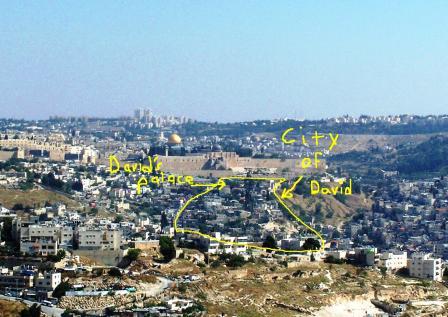
When David became king he conquered the city of the Jebusites also known as the fortress of Zion. This is Jerusalem and was called the city of David for the first little while. That was 3000 years ago. In fact, it was thought to have been 1007 BC (but it varies). In any case they held the 3000th anniversary of Jerusalem as the capital of Israel a few years ago. Anyway, the City of David now is the part of Jerusalem where David once lived and is a tiny hilltop down the hill from the temple mount like in this picture. Naturally it was a small town in the beginning but compared to how the town has grown now its really small.
Anyway, Israel has done a bunch of archeology on the site because it supports their claim on the country. They have found the foundations of what they think was David’s palace at the top of the city. So you can imagine in the evening King David was walking on a roof top somewhere in this area.
He looked down and saw a certain Bathsheba which led to a fall from grace, the next king of Israel, and eventually to Christ.
They found two tombs as well which might have been where Solomon and David were buried. (the bible does say David was buried in the city of David which is unusual because tombs are always outside of the city walls (unless you are the king) These tombs were inside the wall.
The highlight though was walking town a tunnel carved by Hezekiah when the Assyrians conquered the Northern Kingdom of Israel and carried off the ten tribes. Remember that story? Well the armies where headed for the Southern kingdom next and pretty much had it conquered. They were surrounding Jerusalem and things looked pretty bad. Then Isaiah gets up on the city wall and curses the Assyrians. The next day a plague breaks out and the Assyrians leave.
Jerusalem gets another ~120 years to figure things out. Anyway, Hezekiah the king in preparation for this dug a tunnel to bring the Gihon Spring into the walls of the city so they could last the siege. The tunnel is still there 2700 years later and water still flows down it. We walked all the way down it which is something like 1200 cubits or meters or something. It took 30 minutes or so of walking the dark tunnels with water rushing past your feet and not enough space to pass someone. I had to duck for some portions but most of the time the roof was just a little over six feet. Pretty cool tunnel.
At the end of the tunnel a large pool was built to hold the water and provide it to the people. This is called the pool of Siloam. You may remember this pool or name from a feast Adonijah had when he thought he was going to be king. Ok, I didn’t either. Adonijah was one of David’s sons and tried to become king when David was wayy old and blind and deaf. Solomon realizes this and gets crowned king (at the Gihon spring which is the beginning of the tunnel not the end) just in time and later kills his elder brother Adonijah. (oh, Gihon is also one of the rivers that flows from the garden of Eden just to make things a little more confusing). Anyway the place where Adonijah had his victory feast turns into a town named Siloam which becomes the name of the pool around the time of Christ. Christ heals a man by anointing his eyes with mud and telling him to wash in the pool of Siloam whereupon doing so he is healed.
For the record, I tried washing my eyes in the water and I’m pretty sure it wasn’t the water that healed the man.
One more story. Recently President Uchtdorf told the story of Nehemiah and the rebuilding of the walls of Jerusalem. Right on top of David’s palace was a fragment of that wall. The few stones in this picture are thought to have come from that. Everything around them is ruins of David’s palace, the Milo (which was basically a retaining wall and is mentioned in the bible), and whatever houses were built there afterward. By the way, there are still people living in this area (they don’t really appreciate the archeologists digging out the foundation of their houses to find the foundations of David’s.)
Ok, so to review
- Salem 2000 BC (OK, I didn’t mention that and I don’t think we found any ruins specifically from that (although they did find stuff from the Jebusites))
- David conquers city 1000ish BC
- Solomon and Adonijiah ~960 BC (city expanded to include temple mount)
- Hezekiah and Assyrian siege 722 BC tunnel built, city saved (thanks Isaiah!) Also triples in size due to refugees from Northern kingdom of Israel
- Lehi leaves 600 BC (he was one of those northern refugees and probably lived in the expanded portion of the city, inside some walls but outside the walls around the City of David)
- Zedekiah 587 BC (he didn’t listen to Jeremiah) City sacked, temple destroyed
- Nehemiah ~440 BC . rebuilds wall but not in the same place exactly (the Jewish return was a few decades earlier)
- Christ heals man via waters of Siloam AD 32
- Jews return to city of David AD 1850 (its mainly an Arab neighborhood)
- Riley wanders over ruins dating from all the above time periods and gets wet up to his knees AD June 7, 2010

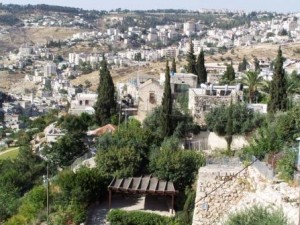
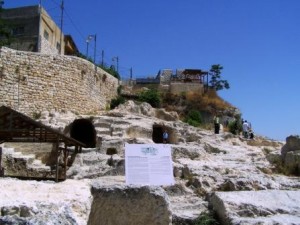
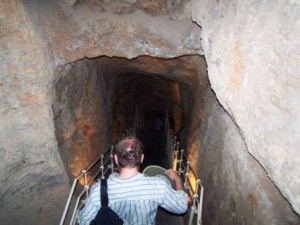
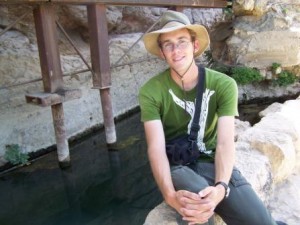
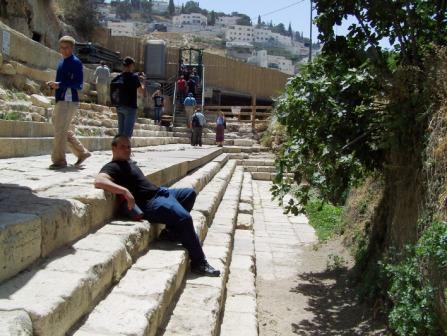
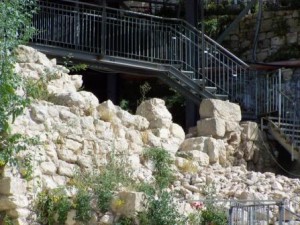
After reading the humorous misspelled test answers above, I noticed this phrase in your writing: “When David became kind he conquered the city…”